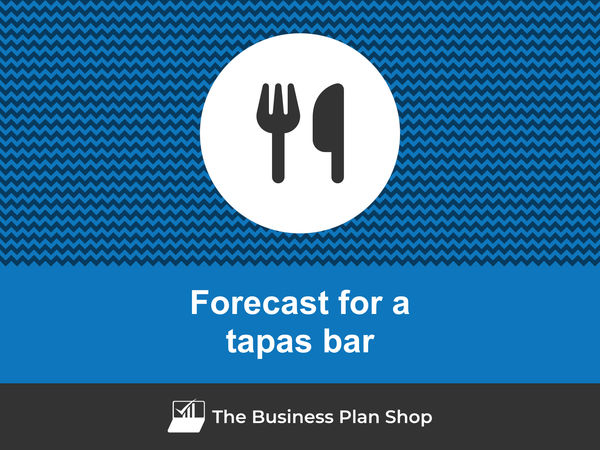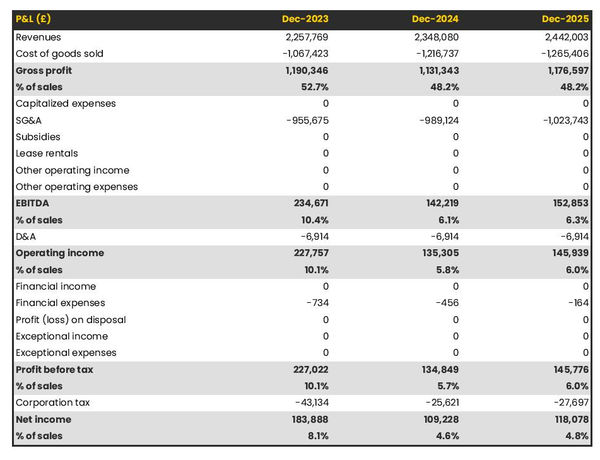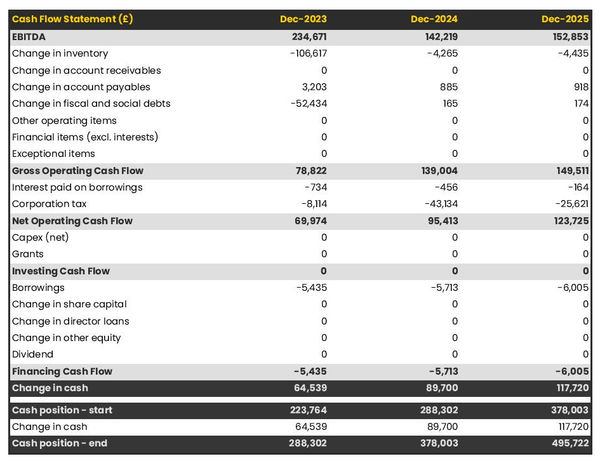How to create a financial forecast for a tapas bar?

Developing and maintaining an up-to-date financial forecast for your tapas bar is key in order to maintain visibility on your business’s future cash flows.
If you feel overwhelmed at the thought of putting together a tapas bar financial forecast then don’t worry as this guide is here to help you.
We'll cover everything from: the main objectives of a financial forecast, the data you need to gather before starting, to the tables that compose it, and the tools that will help you create and maintain your forecast efficiently.
Let's get started!
Why create and maintain a financial forecast for a tapas bar?
Creating and maintaining an up-to-date financial forecast is the only way to steer the development of your tapas bar and ensure that it can be financially viable in the years to come.
A financial plan for a tapas bar enables you to look at your business in detail - from income to operating costs and investments - to evaluate its expected profitability and future cash flows.
This gives you the visibility needed to plan future investments and expansion with confidence.
And, when your trading environment gets tougher, having an up to date tapas bar forecast enables you to detect potential upcoming financing shortfalls in advance, enabling you to make adjustments or secure financing before you run out of cash.
It’s also important to remember that your tapas bar's financial forecast will be essential when looking for financing. You can be 100% certain that banks and investors will ask to see your numbers, so make sure they’re set out accurately and attractively.
Need a solid financial forecast?
The Business Plan Shop does the maths for you. Simply enter your revenues, costs and investments. Click save and our online tool builds a three-way forecast for you instantly.

What information is needed to build a tapas bar financial forecast?
The quality of your inputs is key when it comes to financial modelling: no matter how good the model is, if your inputs are off, so will the forecast.
If you are building a financial plan to start a tapas bar, you will need to have done your market research and have a clear picture of your sales and marketing strategies so that you can project revenues with confidence.
You will also need to have a clear idea of what resources will be required to operate the tapas bar on a daily basis, and to have done your research with regard to the equipment needed to launch your venture (see further down this guide).
If you are creating a financial forecast of an existing tapas bar, things are usually simpler as you will be able to use your historical accounting data as a budgeting base, and complement that with your team’s view on what lies ahead for the years to come.
Let's now zoom in on what will go in your tapas bar's financial forecast.
The sales forecast for a tapas bar
From experience, it is usually best to start creating your tapas bar financial forecast by your sales forecast.
To create an accurate sales forecast for your tapas bar, you will have to rely on the data collected in your market research, or if you're running an existing tapas bar, the historical data of the business, to estimate two key variables:
- The average price
- The number of monthly transactions
To get there, you will need to consider the following factors:
- Menu offerings: The variety and quality of your tapas dishes can greatly impact the average price and number of transactions. Offering unique and high-quality tapas can justify higher prices and attract more customers.
- Seasonal trends: Tapas bars may experience fluctuations in business depending on the time of year. For example, summer months may see an increase in customers due to tourists, while winter months may see a decrease in business.
- Competition: The number and quality of other tapas bars in your area can affect your business's average price and number of transactions. If there are many competitors offering similar dishes, you may need to adjust your prices or offer promotions to attract customers.
- Cultural events: Hosting or participating in cultural events, such as food festivals or cultural celebrations, can attract a larger customer base and potentially increase your average price and number of transactions.
- Customer reviews: Positive or negative reviews can greatly impact your tapas bar's reputation and therefore affect your ability to charge higher prices and attract customers. It's important to consistently monitor and respond to reviews to maintain a positive image.
Once you have an idea of what your future sales will look like, it will be time to work on your overhead budget. Let’s see what this entails.
Need inspiration for your business plan?
The Business Plan Shop has dozens of business plan templates that you can use to get a clear idea of what a complete business plan looks like.

The operating expenses for a tapas bar
Once you know what level of sales you can expect, you can start budgeting the expenses required to operate your tapas bar on a daily basis.
Expenses normally vary based on how much revenue you anticipate (which is why, from experience, it is always better to start your forecast with the topline projection), and where your business is based.
Operating expenses for a tapas bar will include some of the following items:
- Staff Costs: This includes salaries, wages, bonuses, and benefits for all employees, such as chefs, servers, bartenders, and kitchen staff.
- Accountancy Fees: Hiring an accountant to help with bookkeeping, payroll, tax preparation, and other financial tasks.
- Insurance Costs: This includes liability insurance, property insurance, and workers' compensation insurance to protect your business and employees.
- Software Licences: Purchasing or subscribing to software for managing reservations, inventory, and sales, as well as accounting and payroll software.
- Banking Fees: Fees for maintaining a business bank account, processing credit card payments, and depositing cash and checks.
- Food and Beverage Costs: The cost of ingredients and supplies needed to create and serve tapas dishes and drinks.
- Rent: The cost of leasing or renting the space for your tapas bar.
- Utilities: This includes electricity, gas, water, and other necessary services for running your tapas bar.
- Marketing and Advertising: The cost of promoting your tapas bar through social media, print ads, and other marketing channels.
- Repairs and Maintenance: Regular maintenance and repairs for equipment, furniture, and the physical space of your tapas bar.
- Cleaning and Sanitization: The cost of cleaning supplies and services to maintain a clean and sanitary environment for your customers.
- Licenses and Permits: Fees for obtaining necessary licenses and permits to operate a tapas bar, such as a liquor license and health department permits.
- Music and Entertainment: The cost of hiring live music or DJs, as well as licensing fees for playing music in your tapas bar.
- Training and Development: Investing in training and development programs for your staff to improve their skills and knowledge.
- Professional Services: This includes fees for legal services, consulting, and other professional services that may be necessary for your tapas bar.
This list will need to be tailored to the specificities of your tapas bar, but should offer a good starting point for your budget.
What investments are needed to start or grow a tapas bar?
Your tapas bar financial forecast will also need to include the capital expenditures (aka investments in plain English) and initial working capital items required for the creation or development of your business.
For a tapas bar, these could include:
- Kitchen equipment: This includes items such as stoves, ovens, refrigerators, and other cooking tools that are necessary for preparing and storing tapas dishes.
- Furniture and decor: This includes tables, chairs, bar stools, lighting fixtures, and other decorative elements that create the atmosphere of a tapas bar.
- Point of sale system: This includes the hardware and software needed to process orders, track inventory, and manage sales in the tapas bar.
- Bar equipment: This includes items such as glasses, shakers, and other tools needed for making and serving drinks in the tapas bar.
- Sound system: This includes speakers, amplifiers, and other audio equipment needed to play music and create ambiance in the tapas bar.
Again, this list will need to be adjusted according to the size and ambitions of your tapas bar.
Need a convincing business plan?
The Business Plan Shop makes it easy to create a financial forecast to assess the potential profitability of your projects, and write a business plan that’ll wow investors.

The financing plan of your tapas bar
The next step in the creation of your financial forecast for your tapas bar is to think about how you might finance your business.
You will have to assess how much capital will come from shareholders (equity) and how much can be secured through banks.
Bank loans will have to be modelled so that you can separate the interest expenses from the repayments of principal, and include all this data in your forecast.
Issuing share capital and obtaining a bank loan are two of the most common ways that entrepreneurs finance their businesses.
What tables compose the financial plan for a tapas bar?
Now let's have a look at the main output tables of your tapas bar's financial forecast.
The projected profit & loss statement
The projected profit & loss shows how profitable your tapas bar is likely to be in the years to come.

For your tapas bar to be financially viable, your projected P&L should ideally show:
- Sales growing above inflation (the higher the better)
- Profit margins which are stable or expanding (the higher the better)
- A net profit at the end of each financial year (the higher the better)
This is for established tapas bars, there is some leniency for startups which will have numbers that will look a bit different than existing businesses.
The projected balance sheet
Your tapas bar's projected balance sheet provides a snapshot of your business’s financial position at year-end.
It is composed of three types of elements: assets, liabilities and equity:
- Assets: represent what the business possesses including cash, equipment, and accounts receivable (money owed by clients).
- Liabilities: represent funds advanced to the business by lenders and other creditors. They include accounts payable (money owed to suppliers), taxes payable and loans from banks and financial institutions.
- Equity: is the combination of what has been invested by the business owners and the cumulative profits and losses generated by the business to date (which are called retained earnings). Equity is a proxy for the value of the owner's stake in the business.

The cash flow projection
The cash flow forecast of your tapas bar will show how much cash the business is expected to generate or consume over the next three to five years.

There are multiple ways of presenting a cash flow forecast but from experience, it is better to organise it by nature in order to clearly show these elements:
- Operating cash flow: how much cash is generated by the tapas bar's operations
- Investing cash flow: what is the business investing to expand or maintain its equipment
- Financing cash flow: is the business raising additional funds or repaying financiers (debt repayment, dividends)
Your cash flow forecast is the most important element of your overall financial projection and that’s where you should focus your attention to ensure that your tapas bar is adequately funded.
Note: if you are preparing a financial forecast in order to try to secure funding, you will need to include both a yearly and monthly cash flow forecast in your tapas bar's financial plan.
Need a solid financial forecast?
The Business Plan Shop does the maths for you. Simply enter your revenues, costs and investments. Click save and our online tool builds a three-way forecast for you instantly.

Which tool should you use to create your tapas bar's financial projections?
Building a tapas bar financial forecast is not difficult provided that you use the right tool for the job. Let’s see what options are available below.
Using online financial forecasting software to build your tapas bar's projections
The modern and easiest way is to use an online financial forecasting tool such as the one we offer at The Business Plan Shop.
There are several advantages to using specialised software:
- You can easily create your financial forecast by letting the software take care of the financial calculations for you without errors
- You have access to complete financial forecast templates
- You get a complete financial forecast ready to be sent to your bank or investors
- You can easily track your actual financial performance against your financial forecast, and recalibrate your forecast as the year goes by
- You can create scenarios to stress test your forecast's main assumptions
- You can easily update your forecast as time goes by to maintain visibility on future cash flows
- You have a friendly support team on standby to assist you when you are stuck
- It’s cost-efficient and much cheaper than using an accountant or consultant (see below)
If you are interested in this type of solution, you can try our projection software for free by signing up here.
Calling in a financial consultant or chartered accountant
Outsourcing the creation of your tapas bar financial forecast is another possible solution.
This will cost more than using software as you can expect as your price will have to cover the accountant’s time, software cost, and profit margin.
Price can vary greatly based on the complexity of your business. For a small business, from experience, a simple three-year financial forecast (including a balance sheet, income statement, and cash flow statement) will start at around £700 or $1,000.
Bear in mind that this is for forecasts produced at a single point in time, updating or tracking your forecast against actuals will cost extra.
If you decide to outsource your forecasting:
- Make sure the professional has direct experience in your industry and is able to challenge your assumptions constructively.
- Steer away from consultants using sectorial ratios to build their client’s financial forecasts (these projections are worthless for a small business).
Why not use a spreadsheet such as Excel or Google Sheets to build your tapas bar's financial forecast?
You and your financial partners need numbers you can trust. Unless you have studied finance or accounting, creating a trustworthy and error-free tapas bar financial forecast on a spreadsheet is likely to prove challenging.
Financial modelling is very technical by nature and requires a solid grasp of accounting principles to be done without errors. This means that using spreadsheet software like Excel or Google Sheets to create accurate financial forecasts is out of reach for most business owners.
Creating forecasts in Excel is also inefficient nowadays:
- Software has advanced to the point where forecasting can be done much faster and more accurately than manually on a spreadsheet.
- With artificial intelligence, the software is capable of detecting mistakes and helping decision-making.
Spreadsheets are versatile tools but they are not tailor-made for reporting. Importing your tapas bar's accounting data in Excel to track actual vs. forecast is incredibly manual and tedious (and so is keeping forecasts up to date). It is much faster to use dedicated financial planning tools like The Business Plan Shop which are built specially for this.
Need a convincing business plan?
The Business Plan Shop makes it easy to create a financial forecast to assess the potential profitability of your projects, and write a business plan that’ll wow investors.

Use our financial projection templates for inspiration
The Business Plan Shop has dozens of financial forecast templates available.
Our examples contain a complete business plan with a financial forecast and a written presentation of the company, the team, the strategy, and the medium-term objectives.
Whether you are just starting out or already have your own tapas bar, looking at our financial forecast template is a good way to:
- Understand what a complete business plan should look like
- Understand how you should model financial items for your tapas bar

Takeaways
- A financial projection shows expected growth, profitability, and cash generation for your business over the next three to five years.
- Tracking actuals vs. forecast and keeping your financial forecast up-to-date is the only way to maintain visibility on future cash flows.
- Using financial forecasting software makes it easy to create and maintain up-to-date projections for your tapas bar.
You have reached the end of our guide. We hope you now have a better understanding of how to create a financial forecast for a tapas bar. Don't hesitate to contact our team if you have any questions or want to share your experience building forecasts!
Need inspiration for your business plan?
The Business Plan Shop has dozens of business plan templates that you can use to get a clear idea of what a complete business plan looks like.

Also on The Business Plan Shop
Know someone who runs or wants to start a tapas bar? Share our financial projection guide with them!




